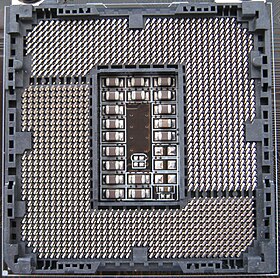
Back Sockel 1155 German LGA 1155 Spanish الجیای ۱۱۵۵ Persian LGA 1155 Finnish LGA 1155 French LGA 1155 Italian LGA1155 Japanese LGA 1155 Georgian LGA 1155 Korean LGA 1155 NB
 | |
| Type | LGA-ZIF |
|---|---|
| Chip form factors | Flip-chip |
| Contacts | 1155 |
| FSB protocol | PCI Express |
| Processor dimensions | 37.5 × 37.5mm 1,406.25mm2[1] |
| Processors | Sandy Bridge Ivy Bridge |
| Predecessor | LGA 1156 |
| Successor | LGA 1150 |
| Memory support | DDR3 |
This article is part of the CPU socket series | |


LGA 1155, also called Socket H2, is a zero insertion force flip-chip land grid array (LGA) CPU socket designed by Intel for their CPUs based on the Sandy Bridge (second generation core) and Ivy Bridge (third generation) microarchitectures.
It is the successor of LGA 1156 (known as Socket H) and was itself succeeded by LGA 1150 in 2013. Along with selected variations of LGA 2011 socket, it was the last Intel socket to fully support Windows XP, Windows Server 2003, Windows Vista, and Windows Server 2008.
LGA 1155 has 1155 protruding pins to make contact with the pads on the processor. The pins are arranged in a 40×40 array with a 24×16 central void and additional 61 omitted pins (two adjoining the central void, six in each of the four corners, and 35 in groups around the perimeter), yielding the 1600 − 384 − 61 = 1155 pin count. Processors for LGA 1155 and LGA 1156 sockets are not compatible with each other since they have different socket notches.
LGA 1155 also marked the beginning of UEFI secure boot with support in some later boards.
- ^ "Intel Core 2 gen CPUs and Socket 1155 Datasheet" (PDF). Intel. Archived from the original (PDF) on February 26, 2017. Retrieved September 26, 2012.
© MMXXIII Rich X Search. We shall prevail. All rights reserved. Rich X Search